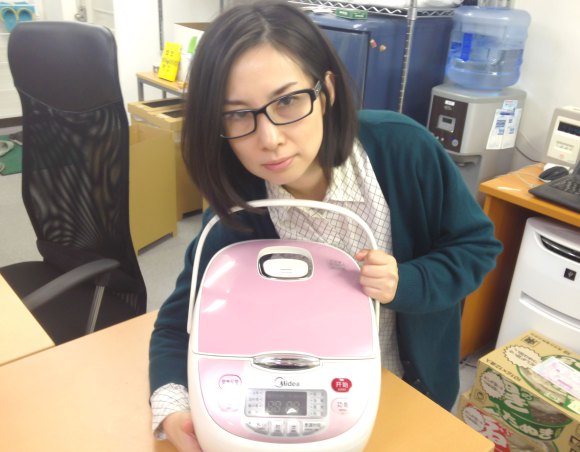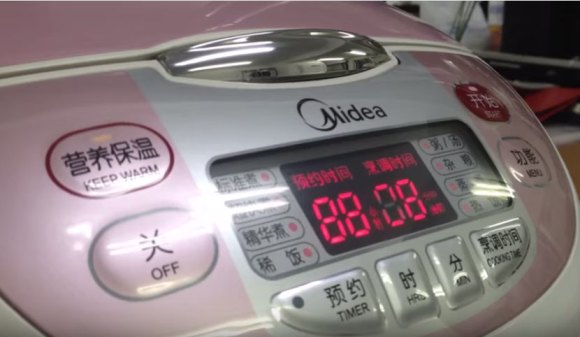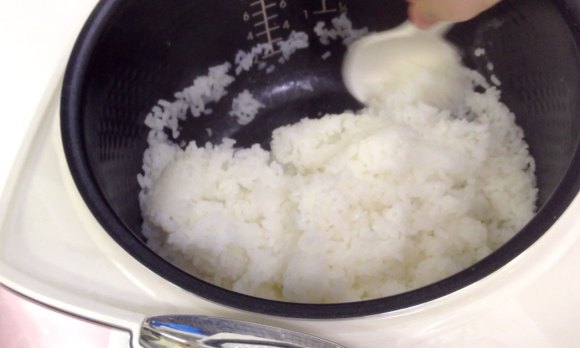
Whether rightfully or not, Chinese products are much maligned for their supposed lack of quality. Even the Chinese people themselves are often critical of their own country’s products, criticizing everything from Chinese news to rice cookers.
But are they really that bad? Our Japanese reporter Meg recently went on a trip to China and brought back a Chinese rice cooker to test it out. She had a couple of surprises along the way, involving everything from getting the rice cooker to even work, to the taste of the final product, so read on to see how it all turned out!
The Chinese rice cooker that Meg purchased is a Midea eight-cup model. She got it in Shanghai for 399 yuan (US$63) and hauled it back to Japan on her return trip. The Midea rice cooker was rated the best Chinese cooker in the world for 12 years straight, so we had high hopes for it here.
▼ “Midea” being a slight rearranging of the romanization of the characters next to it (meide meaning “beautiful”).
▼ D’aww, it’s all pink and round and kind of cute. So far it’s living up to its name.
When Meg bought the rice cooker and told the elderly female store clerk that she intended on using it in Japan, she was laughed at. Apparently it’s very common for Chinese people to import Japanese rice cookers because of their perceived higher quality, so Meg doing the complete opposite kind of blew the woman’s mind.
Still, the clerk was kind enough to remind Meg that she needed to buy a voltage converter if she was going to use the Chinese product in Japan. Japanese and Chinese electric outlet voltages are different, so the rice cooker wouldn’t even work without one. Meg decided she’d cross that bridge back in Japan though, mostly because just carrying the rice cooker already took both her hands so she didn’t have one to spare for a converter.
▼ “So are you gonna help me carry this? No, you’re just gonna keep taking pictures?
Okay then….”
Once back in Japan, Meg called a voltage converter company to see what kind of converter she’d need to buy. The rice cooker’s instructions said it needed 900 watts to work, but the company representative said that rice cookers and other electrical items that get heated up usually require two or three times their printed number.
So just to get the Chinese rice cooker to work, Meg had to buy the strongest converter she could find: a 3000-watt-producing, 24-pound, 34,000 yen ($284) monstrosity. That’s more than four times the price of just the rice cooker itself!
▼ “Hey baby. Is my voltage high enough to turn you on?”
But once everything was plugged in and ready, it was all worth it when the rice cooker actually worked.
▼ Hooray! So, does anyone else have any Chinese goods they need to plug in? Because I really hope I didn’t waste all that money on a converter just for this….
Now came time for the real test: how would it cook the rice? Would it be burnt on the bottom and uncooked on the top? Would it turn to mush? Or would it put Japanese rice cookers to shame and shatter all of our deep-held beliefs?
You can watch a video of the process here, or if you’re impatient/can’t watch videos, then scroll down for spoilers:
.
.
.
.
.
So how did it taste? Well, in the wise words of Meg:
▼ “It tastes just like normal.”
It was a success! …kind of. Nothing incredibly horrible or horribly incredible happened. The rice was just… fine. You can take a look at the final product here:
▼ Yup. It’s rice.
So if the rice from the Chinese cooker turned out just as tasty as a Japanese rice cooker’s, then why do Chinese people still prefer Japanese ones? And why is there such a perceived difference between the two all around the world?
One answer could possibly be that the difference has nothing to do with the rice, but instead is because of the difference in the durability of the rice cookers. Japanese rice cookers are considered to be a long-term investment, lasting for years and years like a piece of furniture.
Chinese rice cookers, even if they produce perfectly delectable rice, have a reputation for not lasting as long as Japanese ones. While we’re not completely sure if this is true or not, if you check out the video above you can see toward the end that the lid of the rice cooker flies up really fast, so much so that it can launch a projectile off it a good distance away. With such intensity being put on the hinge, it’s not hard to imagine that it would snap after not so many uses.
So what do you think? Is the difference between Japanese and Chinese rice cookers purely psychological? Or have you had a bad experience with one or the other and sworn it off forever? Let us know in the comments!
Images ©RocketNews24
[ Read in Japanese ]








 A faster, easier way to make cake: Use a rice cooker【SoraKitchen】
A faster, easier way to make cake: Use a rice cooker【SoraKitchen】 Is a 60,000-yen (US$400) rice cooker worth the price? We rented one to find out
Is a 60,000-yen (US$400) rice cooker worth the price? We rented one to find out Testing out a Japanese rice cooker bag from a 100-yen store
Testing out a Japanese rice cooker bag from a 100-yen store Ultimate lazy sukiyaki – Can you make the king of Japanese hot pots in a rice cooker?【Taste test】
Ultimate lazy sukiyaki – Can you make the king of Japanese hot pots in a rice cooker?【Taste test】 Chicken McNugget rice cooker rice — Can it beat KFC rice cooker rice?【SoraKitchen】
Chicken McNugget rice cooker rice — Can it beat KFC rice cooker rice?【SoraKitchen】 Hayao Miyazaki says Happy New Year to Studio Ghibli fans with new art for Year of the Horse
Hayao Miyazaki says Happy New Year to Studio Ghibli fans with new art for Year of the Horse That time Seiji called JASRAC to ask why he didn’t get paid royalties for his song being on TV
That time Seiji called JASRAC to ask why he didn’t get paid royalties for his song being on TV Turn your old PlayStation console into a light-up clock 【How-to】
Turn your old PlayStation console into a light-up clock 【How-to】 7-Eleven Japan’s ramen-cooking robot whipped us up a bowl of noodles【Taste test】
7-Eleven Japan’s ramen-cooking robot whipped us up a bowl of noodles【Taste test】 Senkoji: The Japanese temple that’s more like a theme park to heaven and hell
Senkoji: The Japanese temple that’s more like a theme park to heaven and hell One of Japan’s rarest sweets is a sell-out hit that looks and tastes like frost
One of Japan’s rarest sweets is a sell-out hit that looks and tastes like frost The mystery destination of the SoraNews24 end-of-year party left us speechless
The mystery destination of the SoraNews24 end-of-year party left us speechless Tuning the RocketNews24 company car to sound like one of our reporters moaning in ecstasy 【Video】
Tuning the RocketNews24 company car to sound like one of our reporters moaning in ecstasy 【Video】 Cafe next to Tokyo Station offers all-you-can-eat tarts, and Mr. Sato is ready for his desserts
Cafe next to Tokyo Station offers all-you-can-eat tarts, and Mr. Sato is ready for his desserts Tokyo’s Tsukiji sushi neighborhood asks tour groups to stay away for the rest of the month
Tokyo’s Tsukiji sushi neighborhood asks tour groups to stay away for the rest of the month Starbucks Japan ready to get Year of the Horse started with adorable drinkware and plushies【Pics】
Starbucks Japan ready to get Year of the Horse started with adorable drinkware and plushies【Pics】 Cyberpunk anime meets traditional culture in Ghost in the Shell gold leaf Japanese changing screens
Cyberpunk anime meets traditional culture in Ghost in the Shell gold leaf Japanese changing screens 7 great places to see Mt. Fuji from without having to climb it
7 great places to see Mt. Fuji from without having to climb it Hello Kitty Choco Egg figures are an adorable trip through three periods of Japanese pop culture【Pics】
Hello Kitty Choco Egg figures are an adorable trip through three periods of Japanese pop culture【Pics】 We found possibly the quietest Japanese-style hotel in Tokyo’s bustling Shinjuku district
We found possibly the quietest Japanese-style hotel in Tokyo’s bustling Shinjuku district Japan’s otoshidama tradition of giving kids money at New Year’s gets a social welfare upgrade
Japan’s otoshidama tradition of giving kids money at New Year’s gets a social welfare upgrade Sumo Sanrio! Hello Kitty and pals team up with Japan Sumo Association for new merch【Pics】
Sumo Sanrio! Hello Kitty and pals team up with Japan Sumo Association for new merch【Pics】 More Than a Capsule Stay: Why Solo Travelers Choose “global cabin Yokohama Chinatown”
More Than a Capsule Stay: Why Solo Travelers Choose “global cabin Yokohama Chinatown” Japan’s oldest largetooth sawfish in captivity back on display in Mie Prefecture
Japan’s oldest largetooth sawfish in captivity back on display in Mie Prefecture 7-Eleven Japan starts new temporary luggage storage service in over 300 branches
7-Eleven Japan starts new temporary luggage storage service in over 300 branches Disillusionment at Tsukiji’s tourist-target prices led us to a great ramen restaurant in Tokyo
Disillusionment at Tsukiji’s tourist-target prices led us to a great ramen restaurant in Tokyo Starbucks teams up with 166-year-old Kyoto doll maker for Year of the Horse decorations【Photos】
Starbucks teams up with 166-year-old Kyoto doll maker for Year of the Horse decorations【Photos】 Tokyo considering law requiring more trash cans following litter increase in heavily touristed area
Tokyo considering law requiring more trash cans following litter increase in heavily touristed area Tokyo event lets you travel back in time, for free, to celebrate 100 years since Showa era start
Tokyo event lets you travel back in time, for free, to celebrate 100 years since Showa era start Sanrio theme park in Japan announces plans to expand into a Sanrio resort
Sanrio theme park in Japan announces plans to expand into a Sanrio resort Japan may add Japanese language proficiency, lifestyle classes to permanent foreign resident requirements
Japan may add Japanese language proficiency, lifestyle classes to permanent foreign resident requirements Stamina-destroying “Paralysis Noodles” are Tokyo’s newest over-the-top ramen innovation
Stamina-destroying “Paralysis Noodles” are Tokyo’s newest over-the-top ramen innovation Survey asks foreign tourists what bothered them in Japan, more than half gave same answer
Survey asks foreign tourists what bothered them in Japan, more than half gave same answer Japan’s human washing machines will go on sale to general public, demos to be held in Tokyo
Japan’s human washing machines will go on sale to general public, demos to be held in Tokyo Japan’s deadliest food claims more victims, but why do people keep eating it for New Year’s?
Japan’s deadliest food claims more victims, but why do people keep eating it for New Year’s? We deeply regret going into this tunnel on our walk in the mountains of Japan
We deeply regret going into this tunnel on our walk in the mountains of Japan Studio Ghibli releases Kodama forest spirits from Princess Mononoke to light up your home
Studio Ghibli releases Kodama forest spirits from Princess Mononoke to light up your home Major Japanese hotel chain says reservations via overseas booking sites may not be valid
Major Japanese hotel chain says reservations via overseas booking sites may not be valid Put sesame oil in your coffee? Japanese maker says it’s the best way to start your day【Taste test】
Put sesame oil in your coffee? Japanese maker says it’s the best way to start your day【Taste test】 No more using real katana for tourism activities, Japan’s National Police Agency says
No more using real katana for tourism activities, Japan’s National Police Agency says Starbucks Japan reveals new sakura drinkware collection, inspired by evening cherry blossoms
Starbucks Japan reveals new sakura drinkware collection, inspired by evening cherry blossoms Updated cherry blossom forecast shows extra-long sakura season for Japan this year
Updated cherry blossom forecast shows extra-long sakura season for Japan this year New Japanese bowl-shaped donburi rice cooker cooks rice and toppings at the same time
New Japanese bowl-shaped donburi rice cooker cooks rice and toppings at the same time We test the new two-in-one curry rice cooker from Japan that’s got everyone talking【Video】
We test the new two-in-one curry rice cooker from Japan that’s got everyone talking【Video】 Don’t throw out leftover rice! Testing to find the best rice freezing/microwaving container
Don’t throw out leftover rice! Testing to find the best rice freezing/microwaving container Rice cooker recipe: How to make a giant cheesy okonomiyaki pancake in a rice cooker
Rice cooker recipe: How to make a giant cheesy okonomiyaki pancake in a rice cooker Rice cooker oden: Quick, cheap, and delicious
Rice cooker oden: Quick, cheap, and delicious How to make amazing sweet apple pancakes using a rice cooker 【RocketKitchen】
How to make amazing sweet apple pancakes using a rice cooker 【RocketKitchen】 This is what happens when you cook rice with coffee in your rice cooker 【Rocket Kitchen】
This is what happens when you cook rice with coffee in your rice cooker 【Rocket Kitchen】 Can you make KFC takikomi gohan in a rice cooker, and is it something worth eating?【SoraKitchen】
Can you make KFC takikomi gohan in a rice cooker, and is it something worth eating?【SoraKitchen】 Japan’s one-person bento box-sized rice cooker can give you freshly cooked rice at the office
Japan’s one-person bento box-sized rice cooker can give you freshly cooked rice at the office New Japanese rice cooker cuts carbohydrates at the push of a button
New Japanese rice cooker cuts carbohydrates at the push of a button Japan goes beyond rice cookers with new curry rice cooker, the kitchen gadget we need right now
Japan goes beyond rice cookers with new curry rice cooker, the kitchen gadget we need right now Train-inspired rice cookers for all the railroad lovers out there
Train-inspired rice cookers for all the railroad lovers out there Check out how this huge chunk of U.S. beef looks after using our rice cooker roasting technique!
Check out how this huge chunk of U.S. beef looks after using our rice cooker roasting technique! Make matcha ice cream rice in your rice cooker with this easy recipe from Meiji
Make matcha ice cream rice in your rice cooker with this easy recipe from Meiji Rice cooker cooking: Bacon onion rice is amazingly easy, awesomely delicious
Rice cooker cooking: Bacon onion rice is amazingly easy, awesomely delicious We examine, sort thousands of grains of rice to test manga-approved cooking method 【Video】
We examine, sort thousands of grains of rice to test manga-approved cooking method 【Video】
Leave a Reply